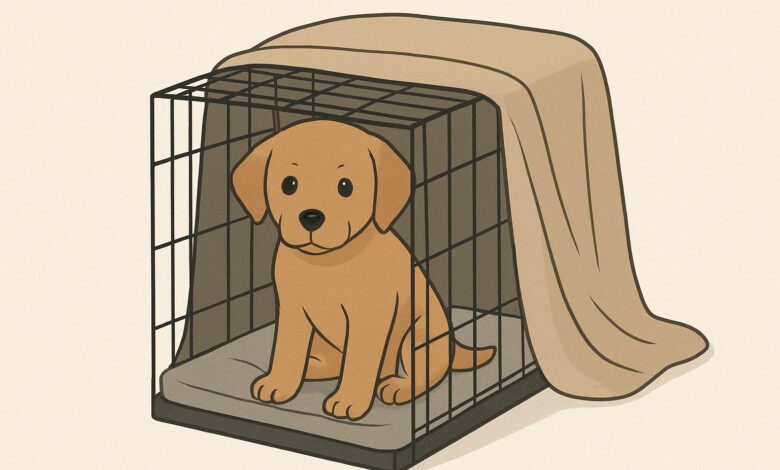
Bringing a new puppy home is an exciting moment, but the first night can be stressful for both you and your furry friend. Puppies are adjusting to a new environment, and being separated from their littermates can make them anxious. Crate training on the first night helps your puppy feel secure, builds good habits, and lays the foundation for a safe and stress-free sleep routine.
In this detailed step-by-step guide, we’ll explain how to crate train a puppy on the first night, reduce whining, and set your dog up for success.
Why Crate Training is Important on the First Night
Crate training is more than just a way to contain your puppy—it mimics the natural den instinct that dogs have. A crate provides:
- Security: Puppies feel safer in a small, enclosed space.
- House Training Help: Puppies learn bladder control and build toilet routines faster.
- Sleep Training: Establishes a nighttime schedule early on.
- Safety: Prevents chewing on dangerous objects when unsupervised.
LSI Keywords: puppy sleep training, benefits of crate training, puppy crying at night, dog crate comfort, new puppy bedtime routine.
Choose the Right Crate
Your puppy’s crate should be comfortable, safe, and properly sized.
- Size matters: The crate should be big enough for your puppy to stand, turn around, and lie down comfortably, but not so big that they use one side as a bathroom.
- Crate type: Wire crates offer visibility and airflow, while plastic crates feel cozier and den-like.
- Comfort inside: Use a soft puppy bed or blanket, but avoid anything that can be chewed and swallowed.
Pro tip: Cover the crate with a light blanket to create a “den-like” environment and reduce external distractions.
Introduce the Crate Before Bedtime
Do not wait until bedtime to introduce the crate. Spend a few hours earlier in the evening helping your puppy associate the crate with positive experiences.
- Place the crate in a quiet but not isolated room.
- Leave the door open and let your puppy explore it freely.
- Add treats, toys, and soft bedding inside to encourage exploration.
- Feed your puppy dinner near or inside the crate to build positive association.
Tire Out Your Puppy Before Bed
A tired puppy is more likely to sleep peacefully through the night.
- Engage in playtime and light exercise.
- Allow them to explore outside (if vaccinated) or indoors with safe games.
- Give bathroom breaks before bedtime to avoid midnight accidents.
Avoid over-excitement right before bedtime—keep the last 30 minutes calm and relaxing.
Establish a Bedtime Routine
Consistency is key in crate training a puppy on the first night. Dogs thrive on predictable routines.
- Final potty break: Always take your puppy outside before placing them in the crate.
- Calming environment: Dim the lights, reduce noise, and keep the house quiet.
- Comfort items: Place a chew toy or a soft blanket that smells like their mother or siblings.
Some owners use a ticking clock or a white noise machine to mimic familiar sounds and reduce anxiety.
Place the Crate in the Right Location
The crate should not be far away from you on the first night. Puppies often feel lonely and scared in a completely new environment.
- Place the crate in your bedroom or near your bed.
- This helps the puppy feel safe knowing you’re nearby.
- Gradually move the crate farther away once your puppy adjusts.
This prevents constant whining and builds trust between you and your puppy.
Handle the First Night Crying
It’s normal for puppies to whine or cry in the crate during the first night. They are not used to being alone.
- Stay calm: Do not immediately let them out when they cry; this teaches them that whining gets results.
- Check needs: If it has been several hours, take them outside for a quick potty break—then back into the crate.
- Reassure gently: Use a calm voice or place your hand near the crate for comfort, but avoid prolonged attention.
Over time, the crying will decrease as your puppy learns that the crate is a safe sleeping spot.
Nighttime Potty Breaks
Puppies cannot hold their bladder through the entire night, especially under 12 weeks old. Plan for at least one or two nighttime potty trips.
- Set an alarm every 3–4 hours during the first few nights.
- Quietly take your puppy outside on a leash for a bathroom break.
- Keep interaction minimal to reinforce that nighttime is for sleeping, not playing.
Gradually, your puppy will develop bladder control and sleep longer.
Morning Routine and Positive Reinforcement
When morning comes, start the day with positivity.
- Take your puppy outside for a potty break immediately.
- Praise and reward them for holding it overnight.
- Give breakfast and playtime outside the crate.
This helps your puppy learn that the crate is for rest and nighttime, not punishment.
Common Mistakes to Avoid in Crate Training
- Using the crate as punishment – This creates fear instead of comfort.
- Leaving the puppy too long – Young puppies need breaks every few hours.
- Ignoring whining without checking – Sometimes your puppy may genuinely need to go outside.
- Lack of consistency – Skipping routines confuses your puppy.
- Moving too fast – Gradually increase crate time for best results.
Long-Term Benefits of Crate Training
- Faster housebreaking success.
- Safe space for your puppy during travel or stress.
- Peaceful sleeping routine for both owner and pet.
- Reduced risk of destructive behavior at night.
Frequently Asked Questions (FAQ)
Q1: How long will my puppy cry in the crate on the first night?
Most puppies cry for the first few nights, but the duration decreases with consistency. Some may adjust within 2–3 nights.
Q2: Should I put toys in my puppy’s crate at night?
Yes, safe chew toys or comfort toys can help reduce anxiety. Avoid plush toys with small parts that can be chewed off.
Q3: Can my puppy sleep in my bed instead of a crate?
While some owners allow this, crate training builds independence and prevents future behavioral issues.
Q4: How many hours can a puppy stay in a crate overnight?
Generally, puppies can hold their bladder for one hour per month of age. For example, a 3-month-old puppy may last 3–4 hours.
Q5: Where should I put my puppy’s crate the first night?
Place it in your bedroom or nearby so your puppy feels secure. You can gradually move it to another area once they adjust.


